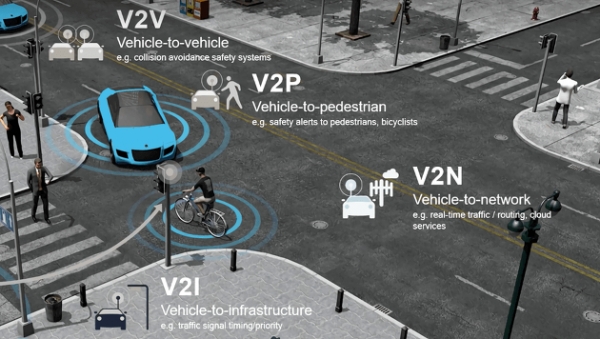
Think of an ambulance carrying an emergency patient. It successfully passed the suburban area with the help of the ground-traffic control center. However, in the urban area, the patient is running out of time due to traffic congestion. Dramatically, the C-ITS integrated control center manages the situation and changes all traffic lights on the ambulance route to the green. The patient safely arrives at the hospital on time. This is just an example of what the Cooperative Intelligent Transport System (C-ITS) does.
The C-ITS is a next-generation model of the Intelligent Transport System (ITS). The current ITS combines electronic control and communication with a variety of transportation and related facilities. Real-time traffic information, traffic intersection control and Hi-pass are some examples based on the ITS.
The C-ITS is an expansion of the ITS, applying the Vehicle to Everything (V2X) technology. The V2X technology allows exchanging information between vehicles, roads and other infrastructure-built objects through wired and wireless networks. Using the V2X technology, information flows between vehicles and infrastructure, constructing a massive system of information. Beyond the level of real-time traffic information, the C-ITS shares pedestrian and vehicle location data to utilize them for real-time autonomous driving and combine traffic conditions collected by all vehicles to reduce traffic jams.
South Korea has been working on the C-ITS test-run program since 2014. From 2016 to 2020, the C-ITS project was launched on the Daejeon-Sejong highway and urban streets in Daejeon and Sejong. The project has implemented 15 transportation safety services, and developed and established a telecommunication infrastructure. It also standardized and certified standards, developed equipment for certification, analyzed traffic safety effects and economic feasibility. On March 30, 2021, at the ITS/C-ITS promotion speech, the Ministry of Transportation shared its plans to promote the ITS by 2025. It also expressed its intention to confirm the number of subsidies by the end of this year and expand the C-ITS business nationwide.
The commercialized ITS gathers one-way information from the traffic information collection devices, CCTVs, and traffic detectors. The collected information is integrated at the traffic control center, used for analyzing traffic flow or circumstance and then provided to the public via traffic broadcasting, radio, and news. However, the ITS does not relate to safe driving or swift counteracts to traffic accidents since it collects fragmentary traffic information.
The C-ITS performs a higher level of functionality than the ITS, since the data between the vehicles and the roads are shared bidirectionally. The C-ITS collects data from the vehicle and sends it to the control center, where the data is analyzed and sent back to the vehicle. The current C-ITS technology is only at the level to open traffic lights for ambulances, but futuristic C-ITS adapted in autonomous vehicles will be able to identify the location of ambulances and locate themselves to open the way immediately. By commercializing the C-ITS, the Ministry of Transportation expects a 30% increase in travel speed and a 46% decrease in traffic accidents.
The C-ITS is drawing attention as a crucial technology for the completion of safe autonomous vehicle systems and society with fewer traffic accidents.


